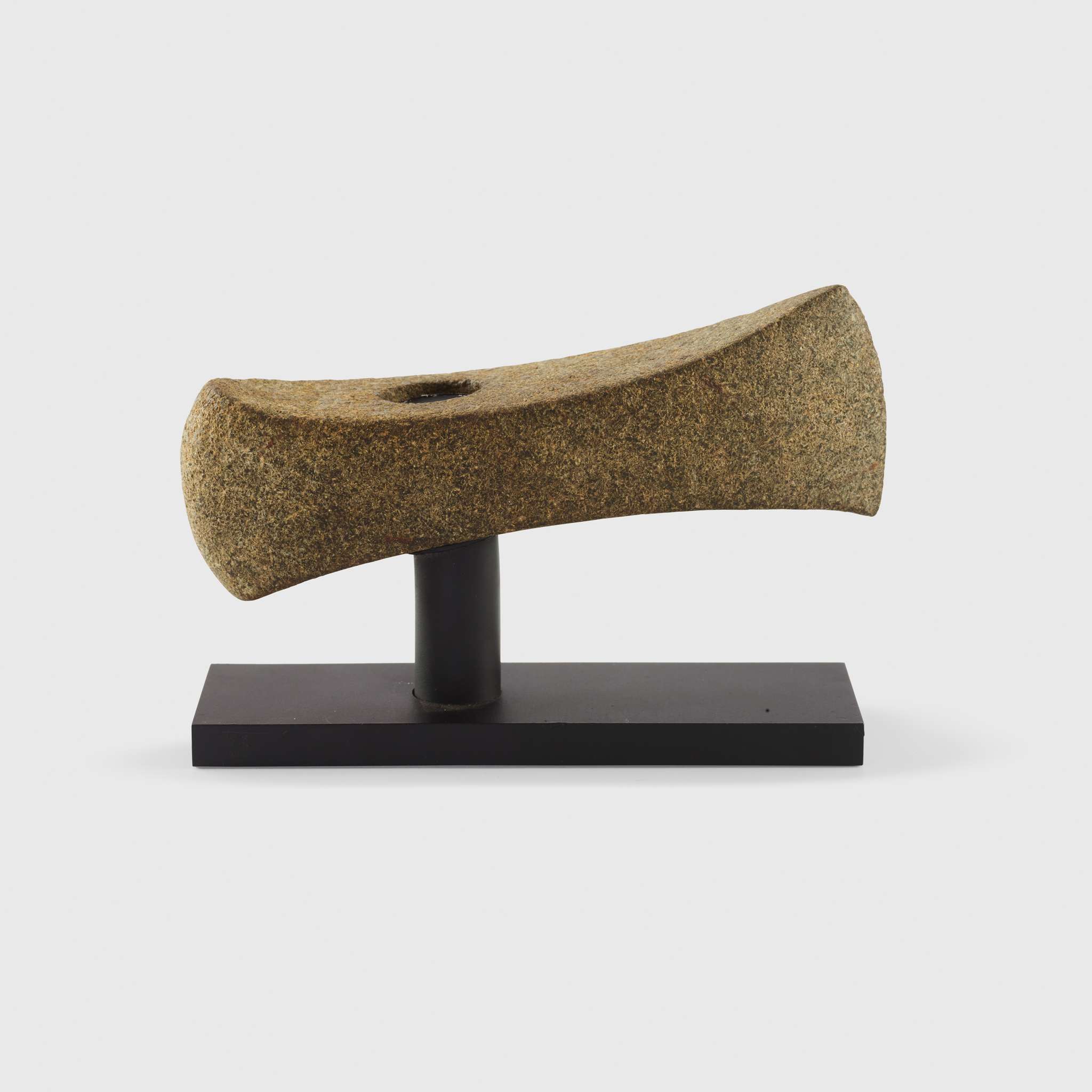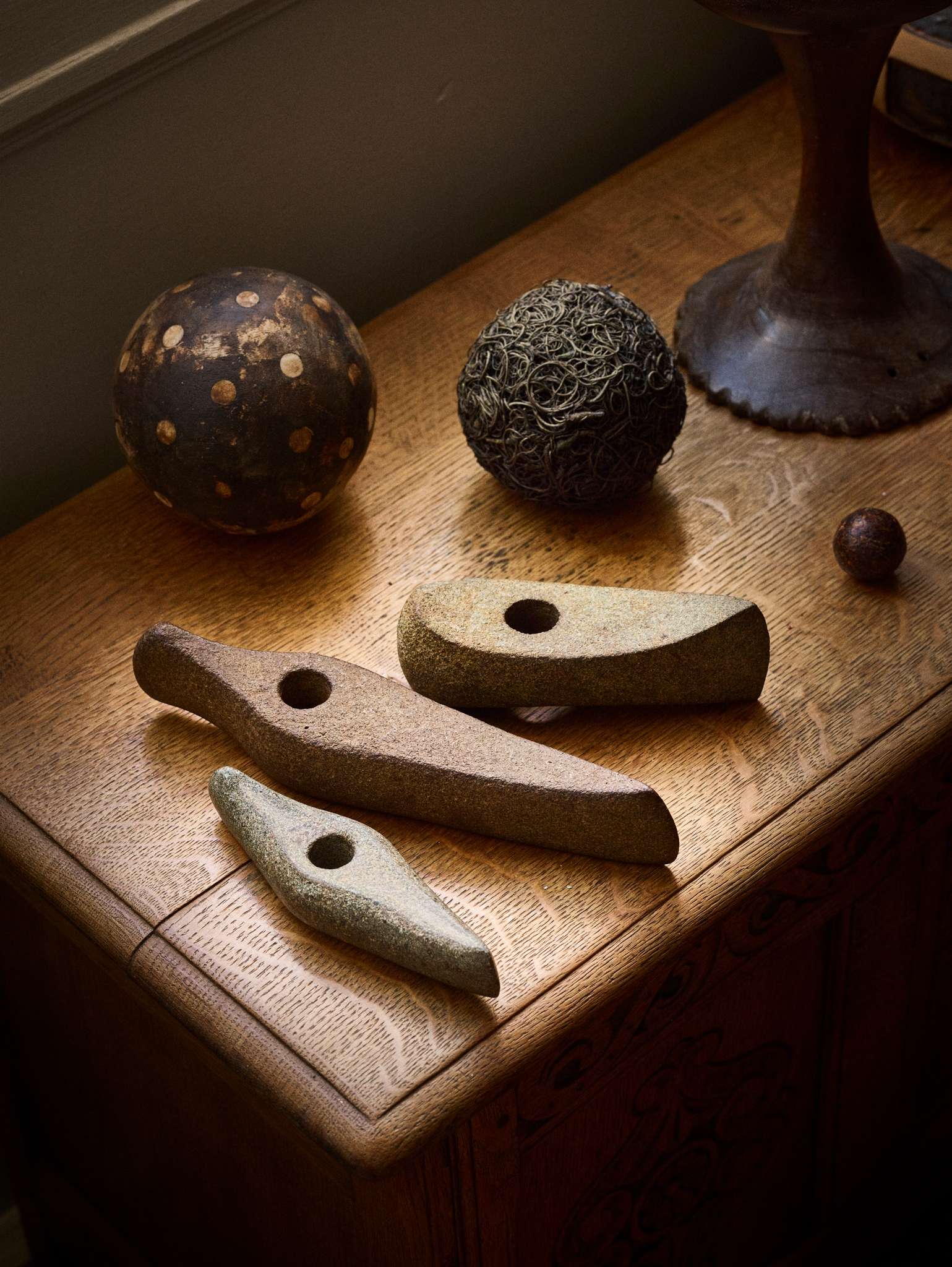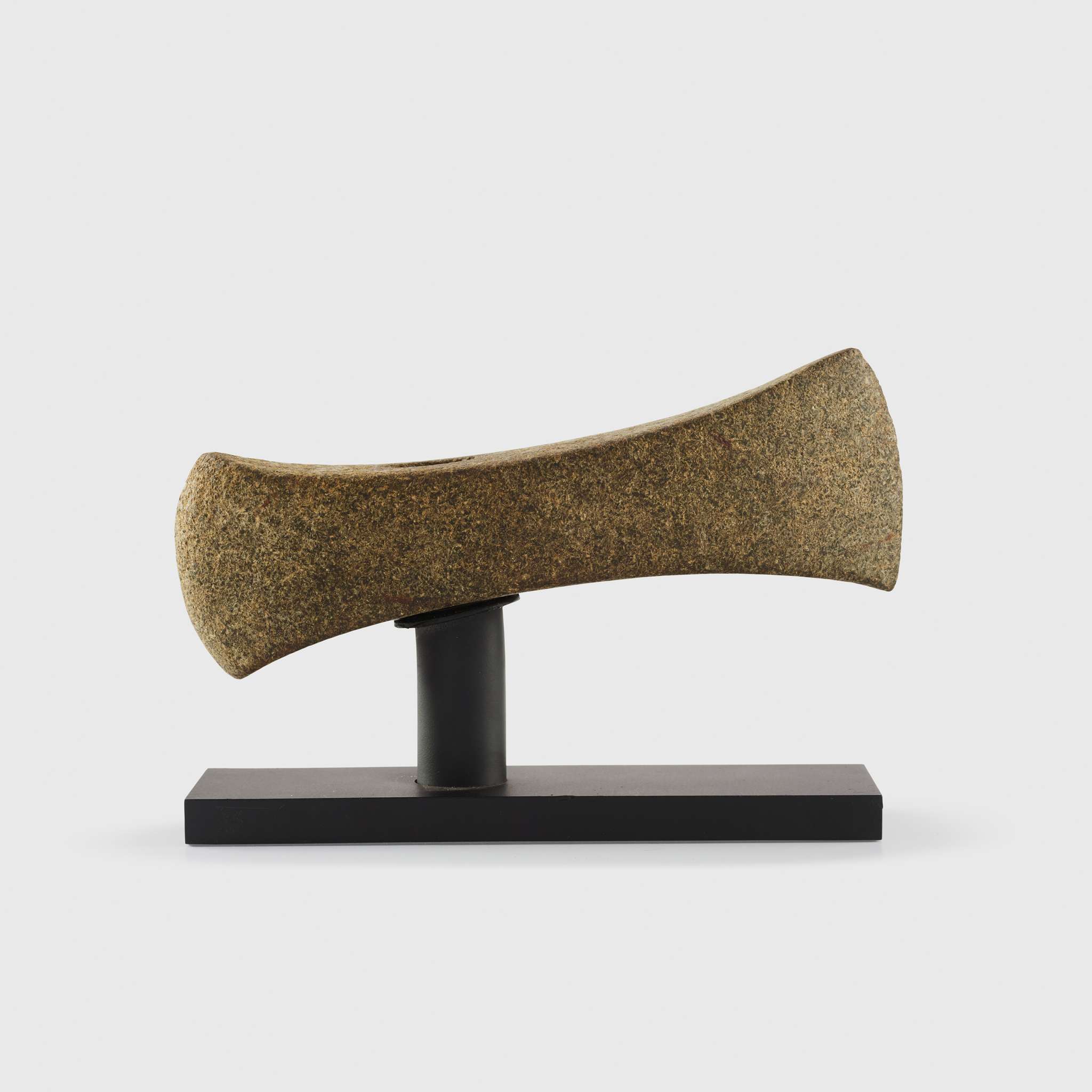78
NORDIC STONE BATTLE AXE
SCANDINAVIA, NEOLITHIC PERIOD, C. 3RD MILLENNIUM B.C.
carved stone, dual cutting edges featuring an elegant tapering form, with an off-centre circular perforation, the surface is smoothly finished with refined contours that emphasise its balanced proportions, raised on a bespoke mount
16.5cm long
Private collection, Belgium
The most significant weapons of Early Bronze Age Europe were not forged from metal but shaped from stone. These remarkable artefacts, in use for over a millennium, were wielded by peoples across a vast expanse from the Baltic to the Atlantic. Far more than mere tools, they were symbols of power, prestige, and cultural identity, their forms and craftsmanship attesting to the sophistication of their creators.They are most closely associated with the archaeological Corded Ware Culture, a society distinguished by its distinctive cord-impressed pottery, which flourished across much of northern and central Europe. Skilled farmers, traders, and warriors, the people of this culture left behind burial sites rich with evidence of complex social structures and belief systems. Among the first to adopt and spread the use of copper and bronze, the Corded Ware people marked a pivotal shift in European metallurgy. Yet, it is the stone battle axes that stand out as some of their most diagnostic objects.Diametrically aligned around a central perforation, these axe-hammers are finely sculpted, with intricate chiselled details that reveal an aesthetic intent behind their design. Among the most striking are the "boat-shaped" models, their sleek profiles reminiscent of Native American canoes (see lot 80), which are characteristic of the late Neolithic period.André Grisse argued these objects were crafted with geometric precision, based on metric standards. He observed: "These artefacts convey a spiritual and ideological message. Their forms, shaped by geometric and mathematical principles, reflect cultural connections across Europe from the late 6th millennium to the mid-3rd millennium B.C. They bore invisible geometric traces, suggesting their creators' advanced understanding of design and symbolism. Those who carried these objects were likely not just warriors but also scholars or astronomers, connected to earthworks."While their imposing forms may suggest a martial purpose, many clues point also to a ceremonial role. Though nothing can be said with absolute certainty about their use, the limited effectiveness of these axes as cutting tools combined with the significant effort required to produce them makes their function as everyday implements unlikely (though there is debate in this respect). Instead, their depiction on funerary stelae alongside warriors, coupled with the exceptional care in their craftsmanship, suggests they symbolised social status. Some examples may even have been influenced by the earliest copper axes emerging in southeastern Europe during the 5th millennium B.C., reinforcing their symbolic significance.So integral were these artefacts to local cultures that miniature versions were created, possibly for personal adornment or ritual use. In southern Sweden, such miniatures have been found in wetland deposits, likely offered as gifts to the watery realm, while in northern Germany, they appear in mortuary contexts linked to cremation practices. Interestingly, while full-sized battle axes are typically associated with male burials, smaller examples are found in contexts involving women and children, suggesting they may have held talismanic properties. Some miniatures display pounding wear on their edges, unseen on full-sized axes, hinting at their use as mortars, perhaps for grinding materials for rituals. These miniatures might even be precursors to Thor’s hammer pendants of the Viking Age.Though we must be cautious when drawing direct connections, there is a further intriguing link between these ancient stone battle axes and the mythological world of the Viking Age, particularly through language. The people of the Corded Ware Culture are believed to have spoken an early form of the Indo-European language family. The Old Norse word hamarr, which describes Thor’s hammer, carries a dual meaning, both "hammer" and "rock." It's Indo-European roots, signifying "pointed," "sharp," and "stone," connect Thor’s weapon to the same qualities embodied by the stone axes wielded by the Corded Ware peoples. This linguistic link suggests that the hammer, much like the stone axes, was seen not just as a tool, but as an object imbued with power and symbolism deeply tied to the natural and metaphysical world.These stone axes appear to have been passed down through generations, with the evidence shown in their wear patterns and reworked edges, indicating prolonged use and careful maintenance. Some axes show signs of resharpening or re-polishing, suggesting they were prized possessions, preserved and adapted for continued use. Their deposition in high-status burials hints at their role as cherished heirlooms, interred at significant moments - possibly the death of the final owner. Others were placed in liminal spaces, such as riverbanks, bogs, or hilltops, indicating they were offerings to mark transitions or connections between realms both physical and spiritual. In later centuries and millennia, the discovery of these stone battle axes often occurred during ploughing, particularly following storms, when the soil was disturbed and these ancient artefacts emerged. Their striking forms, coupled with this timing, led to their association with "thunderstones", a folkloric belief that such objects were remnants of thunderbolts hurled by gods or supernatural beings. In many European traditions, these axes were thought to possess protective or magical properties, guarding homes from lightning, evil spirits, or even the mischief of trolls and fairies.Originally symbols of power, these axes took on new meaning when they were rediscovered in fields, riverbanks, and other liminal spaces. This connection to celestial or magical power deepened their mystique, transforming them from simple tools into sacred relics. In this way, and in a manner that continues to resonate today, objects such as these have seen many lives, first as weapons, then as relics of forgotten pasts, and now as artefacts that continue to captivate and intrigue, bridging the ancient and the modern.Axelsson, B. & Christensen, P.G.R. (eds.) (2004) The Corded Ware Culture in the Neolithic of Europe: A Social and Economic Approach.Beauvarlet, M. (2000) La Hache de Pierre à Travers le Monde. Paris: Editions Errance.Garrow, D. and Wilkin, N. (2022) The World of Stonehenge. London: British Museum Press.
SCANDINAVIA, NEOLITHIC PERIOD, C. 3RD MILLENNIUM B.C.
carved stone, dual cutting edges featuring an elegant tapering form, with an off-centre circular perforation, the surface is smoothly finished with refined contours that emphasise its balanced proportions, raised on a bespoke mount
16.5cm long
Private collection, Belgium
The most significant weapons of Early Bronze Age Europe were not forged from metal but shaped from stone. These remarkable artefacts, in use for over a millennium, were wielded by peoples across a vast expanse from the Baltic to the Atlantic. Far more than mere tools, they were symbols of power, prestige, and cultural identity, their forms and craftsmanship attesting to the sophistication of their creators.They are most closely associated with the archaeological Corded Ware Culture, a society distinguished by its distinctive cord-impressed pottery, which flourished across much of northern and central Europe. Skilled farmers, traders, and warriors, the people of this culture left behind burial sites rich with evidence of complex social structures and belief systems. Among the first to adopt and spread the use of copper and bronze, the Corded Ware people marked a pivotal shift in European metallurgy. Yet, it is the stone battle axes that stand out as some of their most diagnostic objects.Diametrically aligned around a central perforation, these axe-hammers are finely sculpted, with intricate chiselled details that reveal an aesthetic intent behind their design. Among the most striking are the "boat-shaped" models, their sleek profiles reminiscent of Native American canoes (see lot 80), which are characteristic of the late Neolithic period.André Grisse argued these objects were crafted with geometric precision, based on metric standards. He observed: "These artefacts convey a spiritual and ideological message. Their forms, shaped by geometric and mathematical principles, reflect cultural connections across Europe from the late 6th millennium to the mid-3rd millennium B.C. They bore invisible geometric traces, suggesting their creators' advanced understanding of design and symbolism. Those who carried these objects were likely not just warriors but also scholars or astronomers, connected to earthworks."While their imposing forms may suggest a martial purpose, many clues point also to a ceremonial role. Though nothing can be said with absolute certainty about their use, the limited effectiveness of these axes as cutting tools combined with the significant effort required to produce them makes their function as everyday implements unlikely (though there is debate in this respect). Instead, their depiction on funerary stelae alongside warriors, coupled with the exceptional care in their craftsmanship, suggests they symbolised social status. Some examples may even have been influenced by the earliest copper axes emerging in southeastern Europe during the 5th millennium B.C., reinforcing their symbolic significance.So integral were these artefacts to local cultures that miniature versions were created, possibly for personal adornment or ritual use. In southern Sweden, such miniatures have been found in wetland deposits, likely offered as gifts to the watery realm, while in northern Germany, they appear in mortuary contexts linked to cremation practices. Interestingly, while full-sized battle axes are typically associated with male burials, smaller examples are found in contexts involving women and children, suggesting they may have held talismanic properties. Some miniatures display pounding wear on their edges, unseen on full-sized axes, hinting at their use as mortars, perhaps for grinding materials for rituals. These miniatures might even be precursors to Thor’s hammer pendants of the Viking Age.Though we must be cautious when drawing direct connections, there is a further intriguing link between these ancient stone battle axes and the mythological world of the Viking Age, particularly through language. The people of the Corded Ware Culture are believed to have spoken an early form of the Indo-European language family. The Old Norse word hamarr, which describes Thor’s hammer, carries a dual meaning, both "hammer" and "rock." It's Indo-European roots, signifying "pointed," "sharp," and "stone," connect Thor’s weapon to the same qualities embodied by the stone axes wielded by the Corded Ware peoples. This linguistic link suggests that the hammer, much like the stone axes, was seen not just as a tool, but as an object imbued with power and symbolism deeply tied to the natural and metaphysical world.These stone axes appear to have been passed down through generations, with the evidence shown in their wear patterns and reworked edges, indicating prolonged use and careful maintenance. Some axes show signs of resharpening or re-polishing, suggesting they were prized possessions, preserved and adapted for continued use. Their deposition in high-status burials hints at their role as cherished heirlooms, interred at significant moments - possibly the death of the final owner. Others were placed in liminal spaces, such as riverbanks, bogs, or hilltops, indicating they were offerings to mark transitions or connections between realms both physical and spiritual. In later centuries and millennia, the discovery of these stone battle axes often occurred during ploughing, particularly following storms, when the soil was disturbed and these ancient artefacts emerged. Their striking forms, coupled with this timing, led to their association with "thunderstones", a folkloric belief that such objects were remnants of thunderbolts hurled by gods or supernatural beings. In many European traditions, these axes were thought to possess protective or magical properties, guarding homes from lightning, evil spirits, or even the mischief of trolls and fairies.Originally symbols of power, these axes took on new meaning when they were rediscovered in fields, riverbanks, and other liminal spaces. This connection to celestial or magical power deepened their mystique, transforming them from simple tools into sacred relics. In this way, and in a manner that continues to resonate today, objects such as these have seen many lives, first as weapons, then as relics of forgotten pasts, and now as artefacts that continue to captivate and intrigue, bridging the ancient and the modern.Axelsson, B. & Christensen, P.G.R. (eds.) (2004) The Corded Ware Culture in the Neolithic of Europe: A Social and Economic Approach.Beauvarlet, M. (2000) La Hache de Pierre à Travers le Monde. Paris: Editions Errance.Garrow, D. and Wilkin, N. (2022) The World of Stonehenge. London: British Museum Press.
Form Through Time
Auktionsdatum
Ort der Versteigerung
PURCHASE COLLECTIONS FROM FORM THROUGH TIME (SALE 807)
All purchases from this sale can be collected, by appointment, from our London storage partners at Stephen Morris from Monday 17th March at 9am.
They will be stored free of charge until Friday 28th March. From Monday 31st March, clients will be charged by our storage partners.
Insurance 0.25% (all items)Smalls (paintings and objects) - £2.50 admin fee then £1.00 per day. Large or furniture pieces - £5.50 admin fee then £2.50 per day.
Stephen Morris Shipping, 15 Ockham Drive, Greenford, UB6 0FD. Tel 0208 832 2222Open 9am – 5pm by prior appointment only
-----
OTHER CARRIERS
UK & International - Smaller items and paintings
Mailboxes Etc
8 Shepherd Market
Mayfair
London, W1J 7JY
Tel: 0207 491 0022
info@mbemayfair.co.uk
Mailboxes Etc
61 Praed Street
London, W2 1NS
Tel: 0207 706 3666
info@mbepaddington.co.uk
Larger items
Stephen Morris Shipping
Unit 15, Ockham Drive
Greenford, Middlesex
UB6 0FD
+44(0)20 8832 2222
hannah@shipsms.co.uk
Crown Fine Art
Art Central, Union Court
20-22 Union Road
London, SW4 6JP
+44 (0)20 7732 7610
auctionteam.uk@crownww.com
Constantine Moving Services (Specialists in UK & International Shipping)
Constantine House
North Caldeen Road
Coatbridge, ML5 4EF
Tel: 01236 430 681
allanak@constantinemoving.com
A Van Man Transport
Unit 5, Benridge Park
Holyrood Close, Creekmoor
Poole, Dorset, BH17 7BD
Tel: 01202 600 012
office@avmt.co.uk
Gallery Support Group
Unit 4, 89 Manor Farm Road
Wembley
London, HA0 1BA
Tel: 020 305 307 53
info@gallerysupportgroup.com
Wichtige Informationen
BUYER'S PREMIUM
The buyer shall pay the hammer price together with a premium, at the following rate, thereon.
26% up to £20,000
25% from £20,001 to £500,000
20% thereafter
VAT will be charged on the premium at the rate imposed by law (see our Conditions of Sale at the back of this catalogue).
ADDITIONAL VAT
† VAT at the standard rate payable on the hammer price
‡ Reduced rate of 5% import VAT payable on the hammer price
[Ω] Standard rate of import VAT on the hammer price
Lots affixed with ‡ or [Ω] symbols may be subject to further regulations upon export /import, please see Conditions of Sale for Buyers Section D.2.
No VAT is payable on the hammer price or premium for books bought at auction
REGISTRATION
All potential buyers must register prior to placing a bid. Paddle registration must be completed in advance of the sale day. Please note that all first-time, and those returning after an extended period, bidders at Lyon & Turnbull will be asked to supply the following documents in order to facilitate registration:
1 – Government issued photo ID (Passport/Driving licence)
2 – Proof of address (utility bill/bank statement).
By registering for the sale, the buyer acknowledges that he or she has read, understood and accepted our Conditions of Sale.
REMOVAL OF PURCHASES
Responsibility for packing, shipping and insurance shall be exclusively that of the purchaser. See Collections & Storage section for more info specific to this particular auction.
PURCHASE COLLECTIONS FOR SALE 807 FORM THROUGH TIME
All purchases from this sale can be collected, by appointment, from our London storage partners at Stephen Morris from Monday 17th March at 9am.
They will be stored free of charge until Friday 28th March. From Monday 31st March, clients will be charged by our storage partners.
Insurance 0.25% (all items)
Smalls (paintings and objects) - £2.50 admin fee then £1.00 per day.
Large or furniture pieces - £5.50 admin fee then £2.50 per day.
Stephen Morris Shipping, 15 Ockham Drive, Greenford, UB6 0FD.
Tel 0208 832 2222
Open 9am – 5pm by prior appointment only
CATALOGUE DESCRIPTIONS
All item descriptions, dimensions and estimates are provided for guidance only. It is the buyer’s responsibility to inspect all lots prior to bidding to ensure that the condition is to their satisfaction. Our specialists will be happy to prepare condition reports and additional images. These are for guidance only and all lots are sold ‘as found’, as per our Conditions of Sale.
IMPORT/EXPORT
Prospective buyers are advised that several countries prohibit the importation of property containing materials from endangered species, including but not limited to; rosewood, rhino horn, ivory, coral and tortoiseshell. Accordingly, prospective buyers should familiarise themselves with all relevant customs regulations prior to bidding if they intend to import lots to another country. It is the buyer’s sole responsibility to obtain any relevant export or import licence. The denial of any licence or any delay in obtaining licences shall neither justify the recession of any sale nor any delay in making full payment for the lot.
ENDANGERED SPECIES
Please be aware that lots marked with the symbol Y contain material which may be subject to CITES regulations when exporting outside Great Britain. For more information visit https://www.defra.gov.uk/ahvla-en/imports-exports/cites
AGB
UK - Conditions Of Sale For Buyers
These Conditions of Sale and the Saleroom Notices as well as specific Catalogue terms, set out the terms on which we offer the Lots listed in this Catalogue for sale. By registering to bid and/or by bidding at auction You agree to these terms, we recommend that You read them carefully before doing so. You will find a list of definitions and a glossary at the end providing explanations for the meanings of the words and expressions used.
Special terms may be used in Catalogue descriptions of particular classes of items (Books, Jewellery, Paintings, Guns, Firearms, etc.) in which case the descriptions must be interpreted in accordance with any glossary appearing in the Catalogue. These notices and terms will also form part of our terms and conditions of sales.
In these Conditions the words “Us”, “Our”, “We” etc. refers to Lyon & Turnbull Ltd, the singular includes the plural and vice versa as appropriate. “You”, “Your” means the Buyer.
Lyon & Turnbull Ltd. acts as agent for the Seller. On occasion where Lyon & Turnbull Ltd. own a lot in part or full the property will be identified in the catalogue with the symbol (












